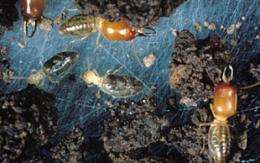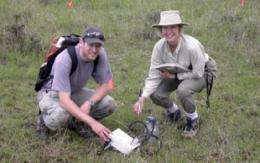Study reveals for first time true diversity of life in soils across the globe, new species discovered

(PhysOrg.com) -- Microscopic animals that live in soils are as diverse in the tropical forests of Costa Rica as they are in the arid grasslands of Kenya or the tundra and boreal forests of Alaska and Sweden, according to a groundbreaking study appearing today in the Proceedings of the Natural Academy of Sciences.
Scientists have generally accepted that a wider range of species can be found above ground at the equator than at the Earth’s poles, but this study proves for the first time that the same rules don’t apply to the nematodes, mites and springtails living underground.
The team of National Science Foundation-funded ecologists on the study includes Tiehang Wu and Jim Garey at the University of South Florida, Diana Wall at Colorado State University, Ed Ayres now at Neon Inc. in Colorado and Richard Bardgett at the University of Lancaster in the United Kingdom.

This is the first comprehensive molecular analysis - at nearly a species resolution - of the global distribution of soil animals across a broad range of ecosystems from the tropics to the poles. Soil samples were taken from 11 sites around the world, including tropical forest in Costa Rica, arid grassland in Kenya, warm temperate forest in New Zealand, shrub steppe of Argentina, and tundra and boreal forest of Alaska and Sweden.
Through DNA testing, researchers found each location had a diversity of soil animals, but each ecosystem is unique with its own soil animals – mostly illustrating an “amazing diversity of species” that had never been discovered before, said Garey, chair of the Department of Cell Biology, Microbiology and Molecular Biology at the University of South Florida.
“On average, 96 percent of our identified soil animals were found at only a single location, suggesting most soil animals have restricted distributions, or in other words, they are endemic,” said biologist Wall, a University Distinguished Professor in biology at Colorado State. “This challenges the long-held view that these smaller animals are widely distributed. However, unlike most above-ground organisms, there was no indication that the latitude made a difference in soil animal diversity.”

“Mites and roundworms dominate soil ecology and contribute to the breakdown and cycling of nutrients in the soil,” Garey said. “These animals are essential to the proper function of the soil ecosystem in natural and farm land.”
The study also examined how the global distribution of soil animals relates to factors such as climate, soil nutrient levels and above-ground biodiversity.
Results showed sites with greater above-ground biodiversity appeared to have lower diversity beneath them in soil. The main factors explaining this low soil animal diversity at sites with high aboveground diversity were high levels of soil inorganic nitrogen availability and lower pH compared with other sites.
Some sites with high animal biodiversity, like the Kenyan grassland site, are considered more at risk due to land use and population increase.
More information: www.pnas.org/content/early/recent
Provided by Colorado State University

















